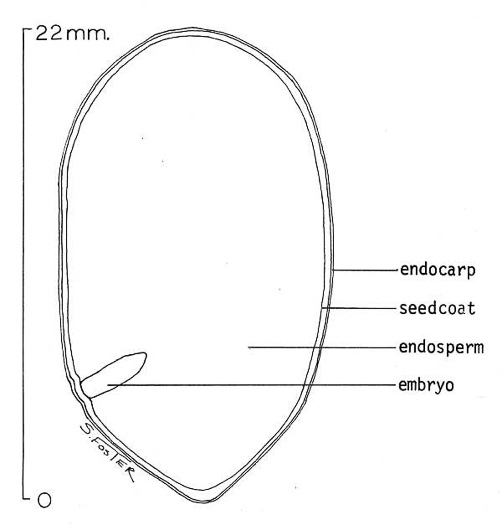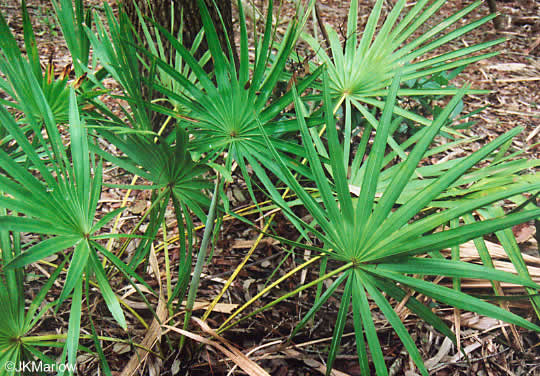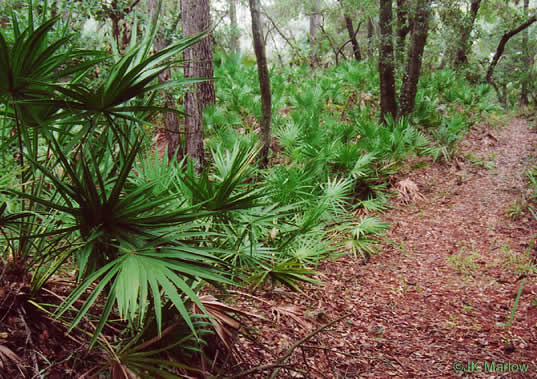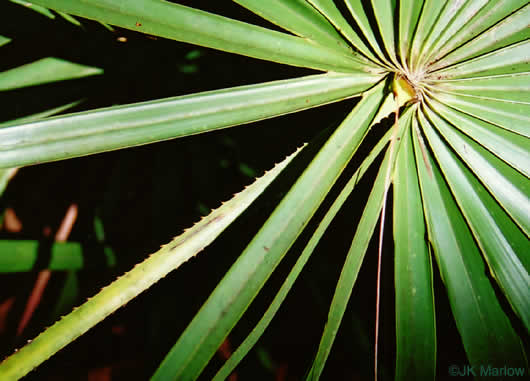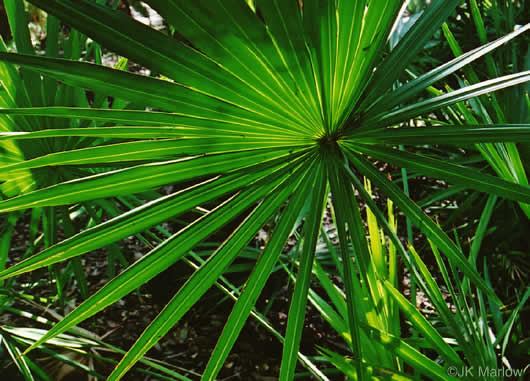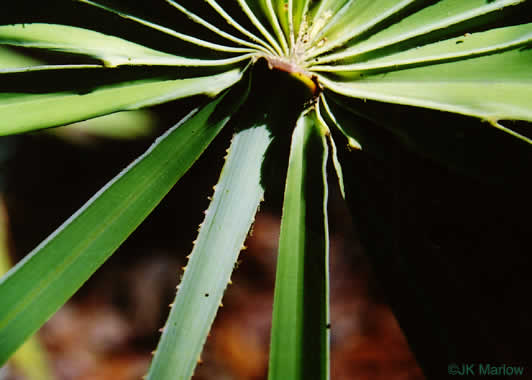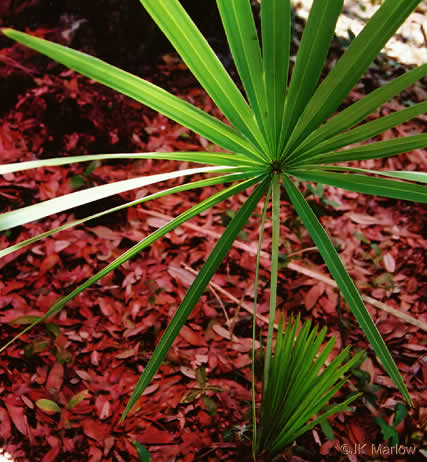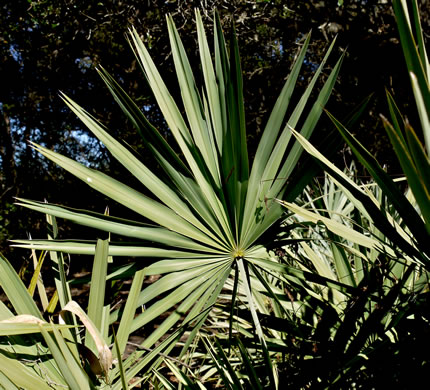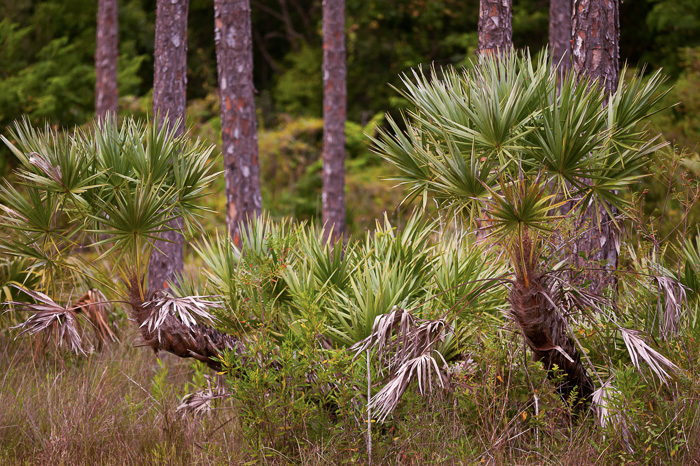Spermatophytes (seed plants): Angiosperms (flowering plants): Monocots: Commelinids: Arecales
WEAKLEY'S FLORA OF THE SOUTHEASTERN US (4/24/22):
Serenoa repens
FAMILY
Arecaceae
Go to FSUS key
Dig deeper at SERNEC, a consortium of southeastern herbaria.
SYNONYMOUS WITH
PLANTS NATIONAL DATABASE:
Serenoa repens
FAMILY
Arecaceae
SYNONYMOUS WITH Flora of North America
Serenoa repens
SYNONYMOUS WITH Floristic Synthesis of North America. BONAP (Kartesz, 2015)
Serenoa repens
SYNONYMOUS WITH Aquatic & Wetland Plants of Southeastern US (Godfrey & Wooten, 1979 & 1981)
Serenoa repens
SYNONYMOUS WITH VASCULAR FLORA OF THE CAROLINAS (Radford, Ahles, & Bell, 1968) 031-01-001:
Serenoa repens FAMILY Arecaceae
SYNONYMOUS WITH Manual of the Southeastern Flora (Small, 1933, 1938)
Serenoa repens
COMMON NAME:
Saw Palmetto
To see larger pictures, click or hover over the thumbnails.
JK Marlow jkm0303g_01
March Beaufort County SC
Hunting Island State Park
Stem horizontal, atop or just below soil surface. Petioles often w prickles, per Forest Plants of the Southeast and Their Wildlife Uses (Miller & Miller, 2005).
JK Marlow jkm0304g_16
April Beaufort County SC
Hunting Island State Park
The petiole is armed with stiff spines, per Trees of the Southeastern United States (Duncan & Duncan, 1988).
![]() COMPARE
Palm and Palmetto species
COMPARE
Palm and Palmetto species
JK Marlow jkm0304g_19
April Beaufort County SC
Hunting Island State Park
Leaf segments lack marginal fibers, per Trees of the Southeastern United States (Duncan & Duncan, 1988).
JK Marlow jkm0304h_20
April Beaufort County SC
Hunting Island State Park
Petiole ends abruptly in the blade base, per Trees of the Southeastern United States (Duncan & Duncan, 1988).
JK Marlow jkm0304i_14
April Beaufort County SC
Hunting Island State Park
Notice the new leaf at the bottom of the picture.
JK Marlow jkm161105_051
November Georgetown County SC
Huntington Beach State Park
Leaves upright, fan-like, nearly circular in outline, per Forest Plants of the Southeast and Their Wildlife Uses (Miller & Miller, 2005).
WEAKLEY'S FLORA OF THE SOUTHEASTERN US (4/24/22):
Serenoa repens
FAMILY
Arecaceae
SYNONYMOUS WITH
PLANTS NATIONAL DATABASE:
Serenoa repens
FAMILY
Arecaceae
SYNONYMOUS WITH
Flora of North America
Serenoa repens
SYNONYMOUS WITH
Floristic Synthesis of North America. BONAP (Kartesz, 2015)
Serenoa repens
SYNONYMOUS WITH
Aquatic & Wetland Plants of Southeastern US (Godfrey & Wooten, 1979 & 1981)
Serenoa repens
SYNONYMOUS WITH
VASCULAR FLORA OF THE CAROLINAS (Radford, Ahles, & Bell, 1968) 031-01-001:
Serenoa repens
FAMILY
Arecaceae
SYNONYMOUS WITH
Manual of the Southeastern Flora (Small, 1933, 1938)
Serenoa repens
If a search such as "Carex leptalea var. leptalea" doesn't deliver the results you want, try "Carex leptalea".
Or, to minimize chances of a misspelling, try just "Carex le".
Less is more: If "pencil flower" doesn't deliver the results you want, try "pencil".

